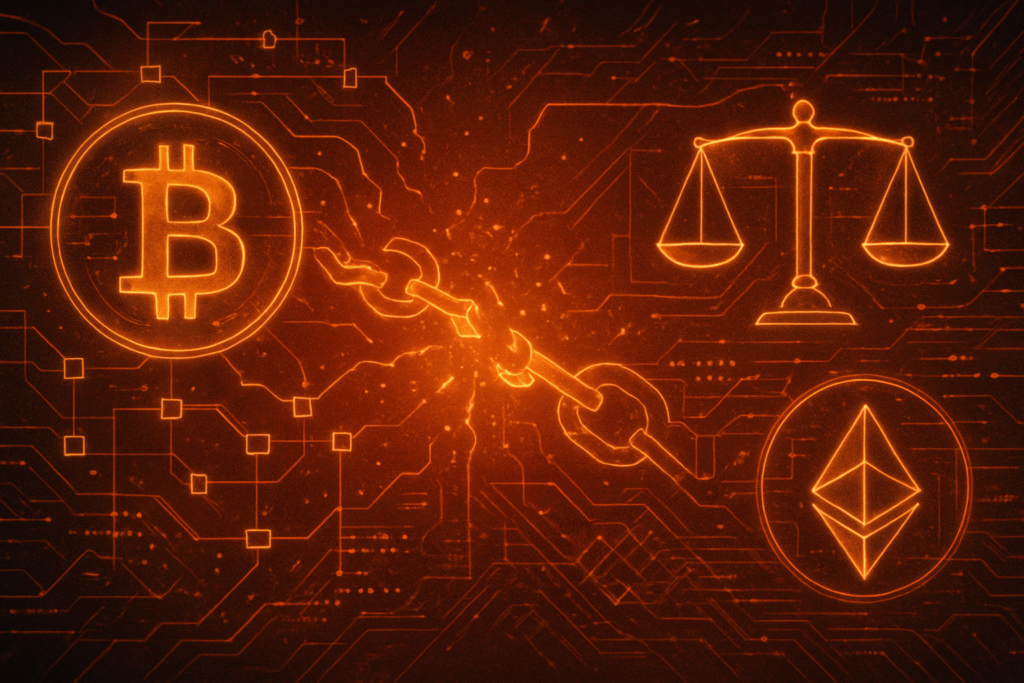
New York, NY – October 14, 2025 – In a landmark case poised to redefine the legal boundaries of decentralized finance, brothers Anton and James Peraire-Bueno, both graduates of the Massachusetts Institute of Technology (MIT), are currently on trial, accused of orchestrating a sophisticated $25 million cryptocurrency heist from the Ethereum blockchain. Their defense, a provocative claim of "outsmarting bots" rather than committing a crime, has ignited a fierce debate within the crypto community and among legal experts, underscoring the complex and often ambiguous nature of digital asset fraud. The trial, which commenced yesterday, October 13, 2025, in Manhattan federal court, marks a critical moment for the burgeoning crypto ecosystem, as it grapples with the interplay between code-driven innovation and traditional legal frameworks.
The alleged theft, meticulously planned for months but executed in a mere 12 seconds in April 2023, involved exploiting a vulnerability within the Ethereum blockchain's Maximal Extractable Value (MEV) boost software. Prosecutors contend that the Peraire-Bueno brothers deployed "bait transactions" to manipulate automated trading bots, ultimately diverting $25 million in valuable cryptocurrency while leaving their victims with "effectively worthless, illiquid junk crypto." The U.S. Department of Justice (DOJ) has characterized this as a "first-of-its-kind manipulation" of the Ethereum blockchain, signaling an aggressive stance against illicit activities in the digital realm. The outcome of this trial is expected to have far-reaching implications for how legal systems globally address protocol-level exploits and automated market activities.
Market Impact and Price Action
The $25 million crypto heist by the Peraire-Bueno brothers in April 2023, while technologically advanced, did not trigger a significant, immediate, and widespread market impact on major cryptocurrencies like Ethereum (ETH) or the broader crypto market. The targeted nature of the exploit, focusing on specific trading bots and transactions within the MEV ecosystem, meant that the immediate financial fallout was largely confined to the direct victims. Unlike "mega-heists" that directly compromise major exchanges or widely used protocols, this incident's scale, though substantial for the individuals involved, represented a relatively small fraction of Ethereum's overall market capitalization and daily trading volume.
Specific price movements of affected tokens, beyond the illiquid assets forced upon the victims, were not widely reported as a major price-moving event for the broader market. The primary impact was on the liquidity pools involved in the manipulated transactions, causing significant losses for the targeted automated traders. Similarly, when the brothers were arrested in May 2024, the market's reaction was muted in terms of immediate price volatility for major cryptocurrencies. Instead, the arrests were viewed more as a statement by law enforcement on its growing capability to prosecute complex digital crimes, aiming to restore confidence in the long term rather than causing short-term price fluctuations.
Comparatively, larger and more generalized attacks, such as the Ronin Network hack ($625 million in 2022) or the ByBit breach ($1.45 billion in February 2025, which led to a 20% drop in Bitcoin's price), have historically caused more pronounced downturns in affected tokens and broader market sentiment. The Peraire-Bueno case, while significant in its legal implications, demonstrates that the market's reaction to crypto heists is highly nuanced, depending on the scale, the specific assets targeted, and the nature of the exploited vulnerability. When an exploit is highly technical and localized, the broader market tends to absorb the news without systemic shock, although concerns about blockchain integrity persist.
Community and Ecosystem Response
The crypto community's reaction to the Peraire-Bueno brothers' alleged heist and subsequent arrests has been a complex tapestry of admiration, criticism, and calls for clarity. Online forums like Reddit saw a spectrum of opinions, with some users acknowledging the brothers' technical ingenuity while others condemned the act as blatant fraud. The debate often circled back to the controversial nature of Maximal Extractable Value (MEV) itself, with some arguing that MEV bots engage in "front-running" practices, blurring the lines of who constitutes a "victim" in such scenarios. This nuanced perspective highlights the internal ethical dilemmas within the decentralized finance (DeFi) space.
Crypto influencers and thought leaders have largely focused on the legal precedent this case will set, particularly concerning the "code is law" philosophy. The defense's argument—that their actions were permissible within the system's code and that traditional wire fraud statutes are unconstitutionally vague when applied to blockchain interactions—directly challenges a core tenet of many crypto enthusiasts. However, the U.S. federal judge's rejection of their bid to dismiss fraud charges underscores a growing legal consensus that traditional laws do apply to actions taken within a decentralized environment. This has prompted discussions about the need for clearer regulatory frameworks that can bridge the gap between technological innovation and legal accountability.
While the incident "calls into question the integrity of blockchain technology" in a general sense, there were no widespread reports of direct, immediate, and systemic negative effects on specific DeFi protocols, NFT projects, or other Web3 applications beyond the directly targeted MEV bots. Flashbots, a key entity in the MEV ecosystem, acknowledged and reportedly patched the bug exploited by the brothers. The broader ecosystem response has leaned towards increased awareness of MEV risks, a push for enhanced security measures, and a renewed emphasis on responsible development and ethical conduct within the blockchain space. The trial is expected to significantly influence future prosecutions of blockchain-related crimes and may lead to accelerated federal enforcement and new guidance on automated trading conduct.
What's Next for Crypto
The Peraire-Bueno brothers' ongoing legal battle is a pivotal moment for the crypto market, with both short-term and long-term implications. In the short term (October 2025 – early 2026), expect heightened regulatory scrutiny and enforcement. A conviction could accelerate federal action and lead to new guidelines for on-chain conduct and automated trading. Regulators are already pushing for Know Your Customer (KYC) and Anti-Money Laundering (AML) compliance, especially for DeFi platforms, as exemplified by the EU's Markets in Crypto-Assets (MiCA) regulation, which mandates licensing for crypto companies by January 2026. This increased oversight could lead to continued market volatility and investor caution, as seen in Bitcoin's price declines after major incidents. Consequently, crypto projects will face immediate pressure to strengthen cybersecurity, adopting multi-party approval systems, mandatory two-factor authentication (2FA), and biometric identity checks. The "code is law" versus traditional legal frameworks debate, central to the Peraire-Bueno defense, will also intensify, with a conviction likely affirming the latter.
Looking further ahead (late 2026 and beyond), the long-term implications point towards a maturation of regulatory frameworks globally. This could involve flexible regulations that foster innovation while protecting users, or stricter oversight that requires DeFi platforms to operate under financial licenses. Clearer regulatory environments, spurred by cases like this, are crucial for greater institutional adoption and trust. Institutions demand robust compliance and security standards to engage with digital assets. We can also anticipate accelerated technological advancements in security and compliance, including AI-driven threat detection, real-time smart contract monitoring, and secure key management. Industry collaboration for shared security standards will also become more prevalent.
Potential catalysts to watch include the verdict in the Peraire-Bueno case, which will set a strong legal precedent. Global regulatory harmonization efforts by bodies like the Financial Action Task Force (FATF) will also be critical. Advancements in privacy-enhancing cryptography, such as Zero-Knowledge Proofs, could offer solutions for privacy-preserving KYC/AML compliance. Strategic considerations for crypto projects include prioritizing security audits, proactive compliance, transparency, and industry collaboration. Investors, on the other hand, should focus on enhanced due diligence, robust risk management, staying informed on regulations, and carefully evaluating custodial versus self-custody options. While the likelihood of increased regulation and market maturation is high, a fragmented global market and a continuous technological arms race with hackers remain medium-high and medium likelihood scenarios, respectively.
Bottom Line
The Peraire-Bueno brothers' case serves as a stark and timely reminder for crypto investors and enthusiasts: the digital asset space, while innovative, is not immune to sophisticated exploits and the long arm of the law. Key takeaways include the inherent vulnerability of even core blockchain protocols, the escalating sophistication of attackers, and the undeniable reality of growing regulatory scrutiny and enforcement. The Department of Justice's proactive stance signals that technical exploits leading to financial gain will be prosecuted as criminal fraud, challenging the "code is law" narrative. This necessitates enhanced due diligence from investors and a deeper understanding of complex blockchain mechanisms like MEV.
The long-term significance of this case cannot be overstated. It will likely establish crucial legal precedents for blockchain exploitation, shaping future regulatory landscapes for decentralized finance. A conviction could bolster investor confidence by demonstrating accountability, ultimately fostering a more secure and trustworthy environment for crypto adoption. However, the very discussion around the "integrity of the blockchain" being called into question also reinforces skepticism, highlighting the need for continuous security enhancements and clear ethical guidelines for developers. For crypto adoption to truly flourish, the industry must proactively address vulnerabilities and collaborate with regulators to establish robust, enforceable legal frameworks that protect users without stifling innovation.
Final thoughts on crypto adoption suggest a maturing ecosystem where illicit gains are pursued, and accountability is sought. This evolution, while potentially leading to a less "wild west" environment, is crucial for mainstream acceptance. The industry must clearly differentiate between legitimate algorithmic arbitrage and fraudulent manipulation to foster healthy growth.
Important dates, events, and metrics to monitor include:
- October 14, 2025: The ongoing criminal trial of the Peraire-Bueno brothers in Manhattan federal court. The proceedings, including witness testimonies and legal arguments, will be closely watched.
- Trial Verdict and Sentencing: The outcome of the trial, including any convictions and the severity of sentences, will set a significant legal precedent.
- Appeals: Any subsequent appeals will further define legal interpretations and potentially delay final outcomes.
- Regulatory Developments: Keep an eye on new pronouncements or enforcement actions from the Department of Justice, the Securities and Exchange Commission (SEC), or other global regulatory bodies concerning MEV, blockchain exploits, or digital asset market manipulation.
- Blockchain Security Updates: Monitor for significant upgrades or patches to the Ethereum protocol and MEV-boost software, as well as new security standards adopted across the wider DeFi ecosystem in response to such exploits.
- Crypto Crime Reports: Analyze annual and mid-year reports from organizations like Chainalysis, which track stolen funds, hacking incidents, and evolving threat landscapes.
- Key Crypto Adoption Metrics: Monitor Total Value Locked (TVL) in DeFi, number of active addresses, transaction counts, and developer activity to gauge ecosystem health and user adoption.
This article is for informational purposes only and does not constitute financial or investment advice. Cryptocurrency investments carry significant risk.





